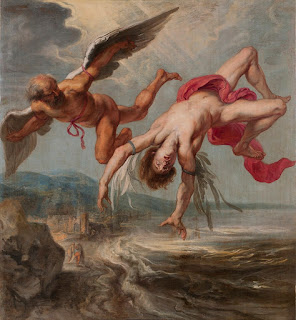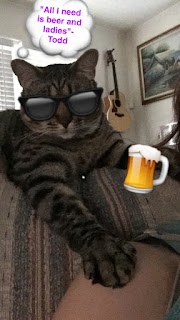Reading Notes: Ovid's Metamorphoses III
I thought the plot of this story was unique because it started off with the story of, The Minotaur, Theseus, and Ariadne, which introduced King Minos and Daedalus. Then the story changes to a third-person point of view of Daedalus and his son Icarus. The use of a metamorphosis in this story are the wings that Daedalus constructed. Typically, when I think of a metamorphosis I imagine a physical transformation. I was surprised to see it used differently and can picture some different ways that I can incorporate in one of my stories in the future. An important event that caught my attention was Icarus' death. The use of foreshadowing revealed how Icarus' ignorance led to his inevitable death.
Icarus falling from the sky. Source: Wikimedia
Something that I will have to attempt is the use of 'beautiful sentences'. The story of Philemon and Baucis is written with extreme attention to detail, as it takes you through every one of Baucis' moves. I like that this story is in the first-person point of view, as it is told by Lelex. I always find it difficult to begin anything that I am writing, as I am pressured with the need to catch the reader's attention within the first paragraph. This story begins with describing the location of Philemon and Baucis' home.
This next section of Philemon and Baucis' story is quite heartwarming. Again, the use of 'beautiful sentences', especially when they were transforming into a tree, was very intriguing to me. I thought it was pretty comical when they were trying to sacrifice their goose escaped and ran to the gods for help. The use of humor, even subtly, always makes reading easier for me; it was something that helped bring my attention back to the story. I like to think that I can be pretty comical sometimes, so I am excited to try it out in a re-creation.
The metamorphosis that is discussed in Autolycus' story is how some gods can transmute into anything they want when they want. This story is unique because it is about Erysichthon's hate for the gods. I like the imagery used in this story; the most disturbing description was, "...blood poured out of its damaged bark, like the crimson tide from its severed neck...". To be honest, I like how evil the main character is, it would be fun to create such a tyrant. I also like the use of a poem/riddle to tell Erysichthon's prophecy.
Something that I always enjoy in a story is the use of personification. This story personified Famine, whose detailed description was horrifying, and Sleep, which seemed comical because Erysichthon dreamed of eating. This story was pretty horrifying in many ways. The first way was how he was always starving. The more he ate, the hungrier he became. Another way it was horrifying was how Erysichthon's daughter begged the gods to "save her from slavery," but she ended up being used by her father. If I were re-creating this story, I could add a storyline about her vengeance against Famine.
This story is a great example of 'Action Writing', it slowly builds up the tension and then escalates into the fighting scene. This style of writing can be difficult, but, with careful attention to detail, can be developed into a scene that makes your heart race. The first-person perspective of Acheloüs' lost battle was entertaining because most of the stories that are memorable to me are from the winner's point of view. It was also fascinating to understand how the scar on his eyebrow came from losing one of his horns when he was in the form of a bull. I also liked the use of overlapping other stories, i.e., Hercules' fight with Hydra.




Comments
Post a Comment